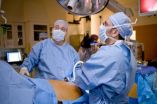(Press-News.org) This time of year many people make resolutions to live a healthier lifestyle, exercise more, lose weight and eat better. For the adolescents who are extremely obese in this country, diet and exercise alone often are not enough to get their weight down. Some of those teens will require weight loss surgery to improve their overall health. According to a recent study published in the January print issue of the Journal of Pediatric Surgery, bariatric surgery in extremely obese adolescents also was shown to be beneficial in helping to reverse previously undiagnosed cardiovascular abnormalities believed to be linked to severe obesity.
The study included a retrospective analysis of 10 adolescent patients (nine female) from Nationwide Children's Hospital who underwent weight loss surgery between August and December 2008. High fidelity imaging using cardiac magnetic resonance (CMR) was performed on these patients in the months leading up to bariatric surgery and revealed heart abnormalities (such as increased left ventricular mass, left ventricular dilation, hypertension) in all patients.
"What we found was that the cardiac structure and function in these extremely obese adolescents scheduled for bariatric surgery, was much more impaired than one might have thought," said study co-author John Bauer, PhD, principal investigator in the Center for Perinatal Research at The Research Institute at Nationwide Children's Hospital. "In addition, more than half of the patients we looked at had significant cardiac abnormalities that would be on par with a middle-aged person with real cardiovascular disease risk in the short term."
VIDEO:
For the adolescents who are extremely obese in this country, diet and exercise alone often are not enough to get their weight down. Some of those teens will require weight...
Click here for more information.
Within the first post-operative year (mean range of 7-13 months), patients were re-evaluated using CMR. Results showed that their previously recorded cardiovascular abnormalities were reversed.
"Many of the abnormalities that we documented during the initial baseline study showed significant improvement after the weight loss had been obtained," said the study's co-author Marc Michalsky, MD, surgical director of the Center for Healthy Weight and Nutrition at Nationwide Children's Hospital. "This is a small, preliminary study that shows the significance of cardiovascular abnormalities in morbidly obese teens and that additional, more robust investigations are needed to understand how weight loss surgery can help this patient population."
In the Center for Healthy Weight and Nutrition at Nationwide Children's, patients first go through several months of evaluation to see if they are even candidates for weight loss surgery. This includes an introductory information session attended by the adolescent and parent and assessments of the potential candidate by a number of staff in the Center including dieticians, bariatric nurse practitioners, psychologists, physical therapists and surgeons. Candidates for weight loss surgery are those that have gone through several failed attempts at diet and exercise regiments. These teenagers have significant organ damage and their quality of life is poor, Dr. Michalsky said.
"Bariatric surgery in adolescents is never a cosmetic procedure," explained Dr. Michalsky who is also a faculty member at The Ohio State University College of Medicine. "These teens are very sick, they are suffering and they can truly benefit in overall health from weight loss surgery."
Nationwide Children's is one of a few centers in the country involved in long-term clinical research of adolescent bariatric surgery, looking not only at what happens in the short-term post-surgery, but long-term as well.
INFORMATION:
For more information on Dr. John Bauer, visit http://www.nationwidechildrens.org/john-a-bauer
For more information on Dr. Marc Michalsky, visit, http://www.nationwidechildrens.org/marc-p-michalsky
For more information on Bariatric Surgery at Nationwide Children's, visit http://www.nationwidechildrens.org/bariatric-surgery-options
For more information on the Center for Healthy Weight and Nutrition at Nationwide Children's, visit http://www.nationwidechildrens.org/center-for-health-weight-nutrition
Study: Bariatric surgery in extremely obese adolescents
May also help treat previously undiagnosed cardiovascular abnormalities
2013-01-22
ELSE PRESS RELEASES FROM THIS DATE:
UBC research: Forget about fair – It's better when bosses pick favorites
2013-01-22
A new study from the University of British Columbia Sauder School of Business shows that bosses should pick favourites if they want top performing teams.
"Conventional wisdom tells us that we should treat everyone the same to create a collegial and productive work atmosphere," says Sauder Professor Karl Aquino, who co-authored the forthcoming study for the Journal of Business Ethics. "But our research shows this can be a disincentive for workers who would otherwise go above and beyond on behalf of the team with a little bit of extra attention."
In a series of experiments, ...
A relative from the Tianyuan Cave
2013-01-22
This press release is available in German.
An international team of researchers including Svante Pääbo and Qiaomei Fu of the Max Planck Institute for Evolutionary Anthropology in Leipzig, Germany, sequenced nuclear and mitochondrial DNA that had been extracted from the leg of an early modern human from Tianyuan Cave near Beijing, China. Analyses of this individual's DNA showed that the Tianyuan human shared a common origin with the ancestors of many present-day Asians and Native Americans. In addition, the researchers found that the proportion of Neanderthal and Denisovan-DNA ...
Enzyme replacement therapy shows promising results in X-linked myotubular myopathy
2013-01-22
A collaborative research team including a Medical College of Wisconsin (MCW) pediatric neuropathologist successfully mitigated some of the effects of a muscular disease by using a new targeted enzyme replacement therapy strategy from 4s3 Bioscience.
The findings are published in the January edition of Human and Molecular Genetics http://hmg.oxfordjournals.org/content/early/2013/01/09/hmg.ddt003.full.pdf+html.
X-linked myotubular myopathy (XLMTM) is a severe muscle disease caused by an absence of a protein called myotubularin. There is currently no treatment for this ...
New 2D material for next generation high-speed electronics
2013-01-22
Scientists at CSIRO and RMIT University have produced a new two-dimensional material that could revolutionise the electronics market, making "nano" more than just a marketing term.
The material – made up of layers of crystal known as molybdenum oxides – has unique properties that encourage the free flow of electrons at ultra-high speeds.
In a paper published in the January issue of materials science journal Advanced Materials, the researchers explain how they adapted a revolutionary material known as graphene to create a new conductive nano-material.
Graphene was ...
Study of how eye cells become damaged could help prevent blindness
2013-01-22
Light-sensing cells in the eye rely on their outer segment to convert light into neural signals that allow us to see. But because of its unique cylindrical shape, the outer segment is prone to breakage, which can cause blindness in humans. A study published by Cell Press on January 22nd in the Biophysical Journal provides new insight into the mechanical properties that cause the outer segment to snap under pressure. The new experimental and theoretical findings help to explain the origin of severe eye diseases and could lead to new ways of preventing blindness.
...
Controlling spine metastases with tumor 'separation surgery' and high-dose stereotactic radiosurgery
2013-01-22
Charlottesville, VA (January 22, 2013). Researchers from Memorial Sloan-Kettering Cancer Center (New York, NY) have found that tumor "separation surgery" followed by high-dose hypofractionated stereotactic radiosurgery (SRS) or high-dose single-fraction SRS is safe and effective in controlling spinal metastases regardless of the radiosensitivity of the particular tumor type that has invaded the spine. This finding is fleshed out in the article "Local disease control for spinal metastases following 'separation surgery' and adjuvant hypofractionated or high-dose single-fraction ...
Evidence mounts for role of mutated genes in development of schizophrenia
2013-01-22
Johns Hopkins researchers have identified a rare gene mutation in a single family with a high rate of schizophrenia, adding to evidence that abnormal genes play a role in the development of the disease.
The researchers, in a report published in the journal Molecular Psychiatry, say that family members with the mutation in the gene Neuronal PAS domain protein 3 (NPAS3) appear at high risk of developing schizophrenia or another debilitating mental illnesses.
Normally functioning NPAS3 regulates the development of healthy neurons, especially in a region of the brain known ...
A diffusion trap
2013-01-22
KANSAS CITY, MO – Over the past several years, Rong Li, Ph.D., at the Stowers Institute for Medical Research has been making crucial discoveries about the development of cell polarity—the process by which one side of a cell becomes different from the other side. Such polarity is critical for the functioning of the vast majority of cells. The outside surface of skin cells is very different from the surface inside the body, for example, while nerve cells have delicately branching dendrites on one end and axons on the other. Li's lab studies yeast cells, which form a unique ...
Synchrotron infrared unveils a mysterious microbial community
2013-01-22
In the fall of 2010, Hoi-Ying Holman of the U.S. Department of Energy's Lawrence Berkeley National Laboratory (Berkeley Lab) was approached by an international team researching a mysterious microbial community discovered deep in cold sulfur springs in southern Germany.
"They told me what they were doing and said, 'We know what you contributed to the oil-spill research,'" recalls Holman, who heads the Chemical Ecology group in Berkeley Lab's Earth Sciences Division. "They wondered if I could help them determine the biochemistry of their microbe samples."
Holman had ...
Immune cells engineered in lab to resist HIV infection, Stanford study shows
2013-01-22
STANFORD, Calif. — Researchers at the Stanford University School of Medicine have found a novel way to engineer key cells of the immune system so they remain resistant to infection with HIV, the virus that causes AIDS.
A new study describes the use of a kind of molecular scissors to cut and paste a series of HIV-resistant genes into T cells, specialized immune cells targeted by the AIDS virus. The genome editing was made in a gene that the virus uses to gain entry into the cell. By inactivating a receptor gene and inserting additional anti-HIV genes, the virus was blocked ...
LAST 30 PRESS RELEASES:
Tracing the quick synthesis of an industrially important catalyst
New software sheds light on cancer’s hidden genetic networks
UT Health San Antonio awarded $3 million in CPRIT grants to bolster cancer research and prevention efforts in South Texas
Third symposium spotlights global challenge of new contaminants in China’s fight against pollution
From straw to soil harmony: International team reveals how biochar supercharges carbon-smart farming
Myeloma: How AI is redrawing the map of cancer care
Manhattan E. Charurat, Ph.D., MHS invested as the Homer and Martha Gudelsky Distinguished Professor in Medicine at the University of Maryland School of Medicine
Insilico Medicine’s Pharma.AI Q4 Winter Launch Recap: Revolutionizing drug discovery with cutting-edge AI innovations, accelerating the path to pharmaceutical superintelligence
Nanoplastics have diet-dependent impacts on digestive system health
Brain neuron death occurs throughout life and increases with age, a natural human protein drug may halt neuron death in Alzheimer’s disease
SPIE and CLP announce the recipients of the 2025 Advanced Photonics Young Innovator Award
Lessons from the Caldor Fire’s Christmas Valley ‘Miracle’
Ant societies rose by trading individual protection for collective power
Research reveals how ancient viral DNA shapes early embryonic development
A molecular gatekeeper that controls protein synthesis
New ‘cloaking device’ concept to shield sensitive tech from magnetic fields
Researchers show impact of mountain building and climate change on alpine biodiversity
Study models the transition from Neanderthals to modern humans in Europe
University of Phoenix College of Doctoral Studies releases white paper on AI-driven skilling to reduce burnout and restore worker autonomy
AIs fail at the game of visual “telephone”
The levers for a sustainable food system
Potential changes in US homelessness by ending federal support for housing first programs
Vulnerability of large language models to prompt injection when providing medical advice
Researchers develop new system for high-energy-density, long-life, multi-electron transfer bromine-based flow batteries
Ending federal support for housing first programs could increase U.S. homelessness by 5% in one year, new JAMA study finds
New research uncovers molecular ‘safety switch’ shielding cancers from immune attack
Bacteria resisting viral infection can still sink carbon to ocean floor
Younger biological age may increase depression risk in older women during COVID-19
Bharat Innovates 2026 National Basecamp Showcases India’s Most Promising Deep-Tech Ventures
Here’s what determines whether your income level rises or falls
[Press-News.org] Study: Bariatric surgery in extremely obese adolescentsMay also help treat previously undiagnosed cardiovascular abnormalities



